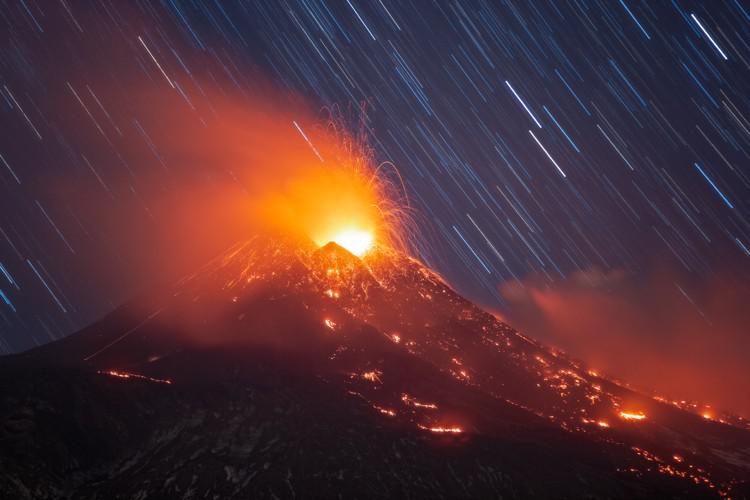This page describes an image Star Trails And Lava Plume on Mount Etna February 2021, by Dario Giannobile, Italy
Caption:
Third place in the IAU OAE Astrophotography Contest, category Star trails.
This spectacular image captures some of the most dramatic expressions of Nature, the eruption of a volcano and the night sky. The volcano in the foreground is Mount Etna, located in Sicily/Italy, during an eruption in February 2021. In the background, we can see the star trails resulting from the Earth's motion around its imaginary axis. As Mount Etna is located about 37° N, we can notice that the arcs are quite open, as this is far from the North Pole, from where the view from the sky would provide traces drawing circles. As we move to the Equator, either from the Southern or Northern Hemisphere, the star traces become more and more parallel, instead of circular, as the viewer moves away from the zenith pointing to one of the Earth's rotational axes. Therefore, the sky presents us with valuable information about location and time and was an important practice for ancient civilizations to follow the movement of the celestial bodies. The image also captures the varying colours of stars which result from differece in the temperature of stars: higher temperature stars are bluer, compared to the lower temperature white and red stars.
Credit:
Dario Giannobile/IAU OAE
DOI: 10.5281/zenodo.5371619
Related glossary terms:
Star Trail
Categories:
Naked Eye Astronomy
License: Creative Commons Attribution 4.0 International (CC BY 4.0) Creative Commons Attribution 4.0 International (CC BY 4.0) icons
The media file captions presented on the OAE website were written, translated and reviewed by a collective effort from the OAE, the OAE Centers and Nodes, the OAE National Astronomy Education Coordinators (NAECs) and other volunteers. You can find a full list of credits for our translation project here. All media file captions are released under a Creative Commons CC BY-4.0 license and should be credited to "IAU OAE". The media files themselves may have different licenses (see above) and should be credited as listed above under "credit".
Captions in Different Languages:
Caption: Terzo posto al concorso di Astrofotografia IAU OAE, categoria "Scie stellari".
Questa immagine straordinaria ritrae insieme due tra le manifestazioni più spettacolari della natura, l'eruzione di un vulcano e il cielo notturno. Il vulcano in primo piano è l'Etna, situato in Sicilia (Italia), fotografato durante un'eruzione nel febbraio 2021. Sullo sfondo si vedono le scie stellari dovute al movimento della Terra intorno al suo asse immaginario. Possiamo notare come gli archi siano piuttosto aperti, in quanto l'Etna si trova ad una latitudine di circa 37° N, e quindi sufficientemente lontano dal Polo Nord, dove invece tutte le tracce stellari si chiuderebbero a cerchio. Spostandosi progressivamente verso l'Equatore, sia nell'emisfero meridionale che in quello settentrionale, le tracce stellari diventano sempre più parallele, anziché circolari, poiché lo zenit dell'osservatore si allontana dall'asse di rotazione della Terra. Pertanto il cielo ci fornisce preziose informazioni sulla posizione e sul tempo, e per le antiche civiltà seguire il movimento dei corpi celesti era un'attività di primaria importanza. L'immagine rivela anche le differenze di colore delle stelle che derivano dalla loro diversa temperatura: le stelle blu hanno una temperatura più elevata rispetto a quelle gialle e rosse.
Credit: Dario Giannobile/IAU OAE
Related glossary terms: Scia stellare Caption translation status: Approved by a reviewer
Caption translators: Giuliana Giobbi, Emanuele Nardini
Caption reviewers: Rodolfo Canestrari, Raffaella Ferretti









